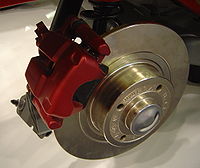
Photo from wikipedia
Abstract The thermal stresses within brake discs have been studied extensively but the mechanical stresses developed from the clamping of the brake discs and applied braking torque from the disc/pad… Click to show full abstract
Abstract The thermal stresses within brake discs have been studied extensively but the mechanical stresses developed from the clamping of the brake discs and applied braking torque from the disc/pad rubbing interface have received little attention. The mechanical stresses in conventional brake disc topologies are well below the strength of typical brake disc materials like grey cast iron and steel. New materials and brake disc designs are currently being developed to reduce the brake disc’s operating temperatures, thermal stresses and mass. The mechanical stresses in these new brake disc designs cannot be ignored and has initiated the need to understand how the mechanical stresses within a brake disc are developed. In this study, the mechanical loading of the brake pads onto a brake disc was separated into the compressive stresses due to the clamping load and the shear stresses due to the applied braking torque. These stresses were measured experimentally using strain gauges mounted on a solid brake disc tested on a custom-built test rig. The results show that for the clamping load test, the disc compressive stresses are concentrated at the disc/pad contact interface and negligible elsewhere. For the applied torque load test, the disc shear stresses are distributed throughout the circumference of the brake disc but are a maximum at the disc/pad contact interface. Finally, a simplified method to calculate the mechanical stresses in a brake disc, using solid mechanics formulae and stress concentration factors, is presented.
Journal Title: Engineering Failure Analysis
Year Published: 2021
Link to full text (if available)
Share on Social Media: Sign Up to like & get
recommendations!